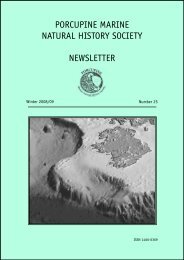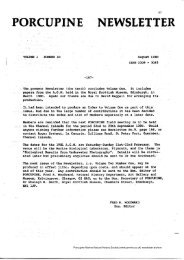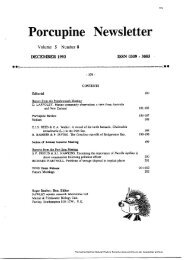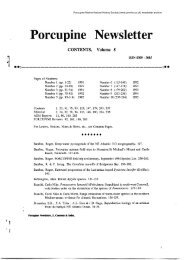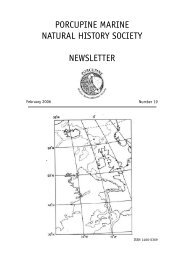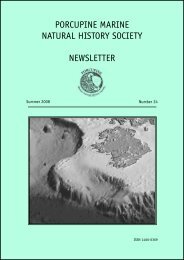Porcupine Newsletter - No. 16 November 2004 - Porcupine Marine ...
Porcupine Newsletter - No. 16 November 2004 - Porcupine Marine ...
Porcupine Newsletter - No. 16 November 2004 - Porcupine Marine ...
You also want an ePaper? Increase the reach of your titles
YUMPU automatically turns print PDFs into web optimized ePapers that Google loves.
9The mucous tubes of S. wigleyi were over20 mm long. Each was limp, gradually taperedfrom the entrance and had sand grainsadhering to the outside except at the rimwhich was presumably constantly being addedto. The fibres of the rods may contribute tothe wall of the tube and some appeared toextend from the outer surface. These free fibrespossibly help anchor the tube to thesurrounding substratum. The tube was notporous to water under pressure from a syringe.Feeding and respiratory currentsThe dorsal transverse lamellae of S. wigleyiconsisted of two epidermal membranesseparated by coelomic space. On the rim ofeach lamella were two parallel rows of 18 mmlong cilia that presumably produce a combinedfeeding and respiratory current. The cilial rootsconsisted of a series of some 40 blocks eachseparated by a large single cell (Fig. 4). Thebroad ventral bases of the notopodal cirricontained elongate mucous glands, and a finetube passed along the cirri. Presumably mucusfrom the cirri is secreted into the current.On occasions yellow amorphous materialsimilar to that seen in the gut was found onthe dorsum behind the head in the region ofthe epaulettes and may have been collectedby the mucous mesh and the palps. Manyspecimens were found with the tentaclesdoubled back with their grooves opposed tothe epaulettes. As in most tentacularpolychaetes the tentacles were easily torn offthe body when the specimens are removedfrom their tubes. When this occurred theepaulettes and the surrounding epidermis werealso torn away (Fig. 5). In other specimensthe epaulettes were found to be loose but stillattached to the body. The tentacles, therefore,appeared to have stuck to the epaulettesduring the transfer of food to the epaulettes.Food and gutThe first 12 chaetigers of S. wigleyi werefound from dissection and whole mounts tocontain a pharynx, which tapered posteriorlyto a muscular gizzard. The wider anterior endof the pharynx had a number of buccal folds,which presumably allows the proboscis to beeverted as was seen in many whole specimens.The gut was thin walled and segmentalpouches started behind the gizzard atchaetiger 15. The pouches contained yellowamorphous material, diatoms and 2.6 mm widefibres with side branches. The diatoms(Distephanus speculum and Cocinodiscusspecies) were common and ranged from 26-80mm but chains of smaller species were alsopresent. On occasions S. wigleyi was founddoubled up in its tube with the anus next tothe head suggesting it was in the process ofexpelling faeces when sampled.Comparison of S. wigleyi, S. bombyx and S.kroyeriThe three species of Spiophanes looked atin this study were found to be generally similarin structure (Table 1). However, as is known,S. kroyeri has longer epaulettes than the othertwo species. In S. wigleyi each epauletteconsisted of a pair of dorsal grooves coveredwith cilia under which were what appeared tobe mucus-secreting cells (Fig. 6). Theepaulettes may move the food collected bythe tentacles towards the mouth (as well asprobably being chemo-sensory, Gibson 1997).However, S. bombyx and S. kroyeri, whichappears to live in much the same type ofsediment (Table 2), have epaulettes that differin length. There were conspicuous groovesrunning around the sides of the head in S.kroyeri, which presumably carry mucous foodthreads to the mouth.ConclusionsSpiophanes wigleyi was sampled by grabfrom the <strong>No</strong>rth Sea and preserved in methanol.A mucous mesh within the tube was apparentlysecreted by sacks in the anterior of the bodyand may have filtered food particles from awater current probably produced by cilia ontransverse lamellae. The species is normally atentacular detritus feeder and the mesh mayonly be produced under conditions wheredetritus on the seabed is in short supplypossibly due to high densities of individuals.PMNHS <strong>Newsletter</strong> <strong>No</strong>.<strong>16</strong> <strong>No</strong>v <strong>2004</strong> 9<strong>Porcupine</strong> <strong>Marine</strong> Natural History Society (www.pmnhs.co.uk) newsletter archive



